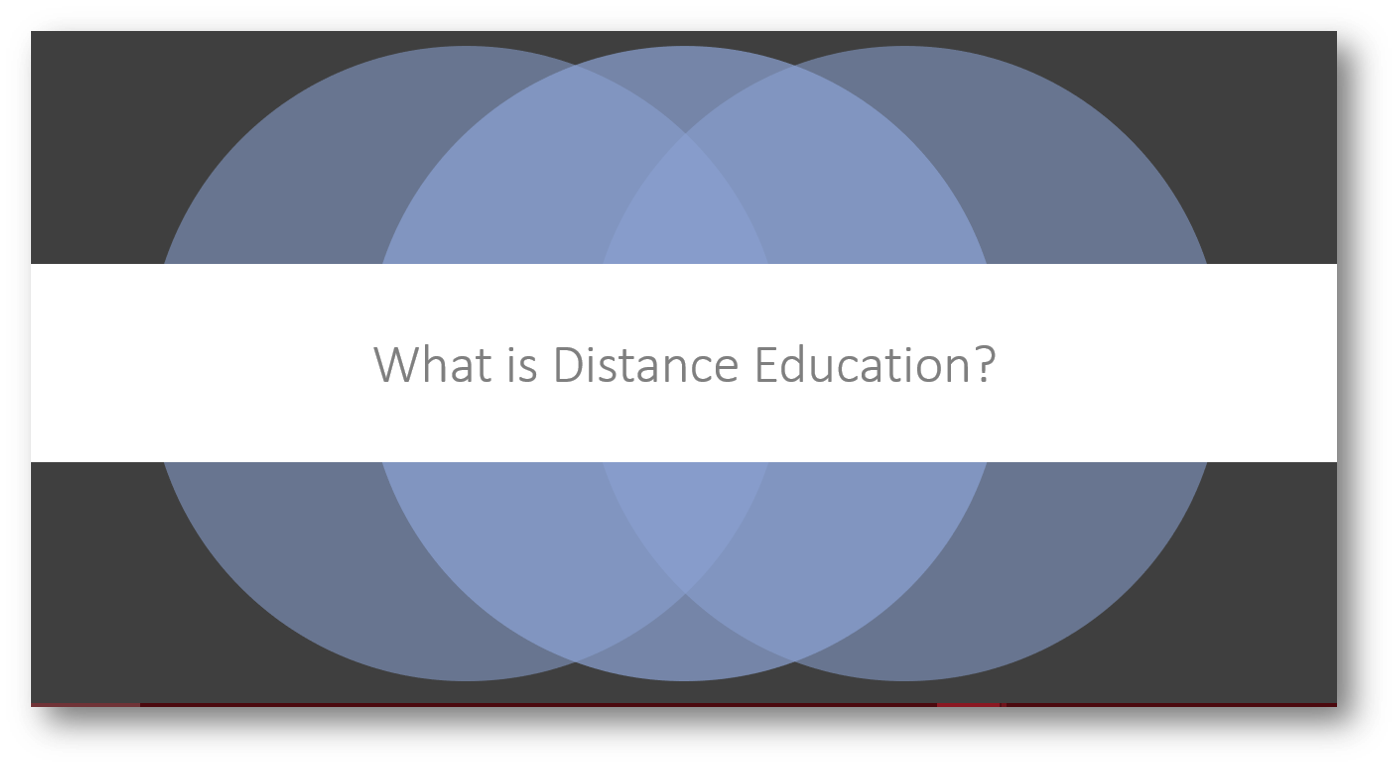Close your eyes (not for too long) and answer the question: “What is distance education?”  Did you envision the same concept and experiences as I did?
Did you envision the same concept and experiences as I did?
Even though more than one-quarter of all higher education students in the United States and a roughly equivalent number in Canada now take at least one distance education course, it is amazing that we still have differences in how we define it.
Does it matter?

Yes.
There could be big differences in counts for funding purposes, counts for research purposes, or in student eligibility for benefits depending on who is setting the definition.
And No. 
Quite often definitions are close enough to not be materially different. Do we need to spend time splitting hairs?
Definitions may differ by accrediting agency, state, province, federal agency, or survey. My guess is that institutional personnel are not following all these differences to the last detail.
As you will see below…it’s a mess.
This year, the U.S. Department of Education has been turned to its Technical Review Panel to consider how to improve the collection of distance education data in its Integrated Postsecondary Education Data System (IPEDS) surveys. WCET responded with input from our members. Below is an excerpt from WCET’s response in which we highlight the differences:
===RESPONSE TO IPEDS ON DEFINING DISTANCE EDUCATION ===
Thank you for the opportunity to comment on the Technical Reviews work regarding distance education data collections in IPEDS. WCET (the WICHE Cooperative for Educational Technologies) sought input from its member institutions throughout the United States. Below are our comments on the Discussion Items from the “IPEDS Technical Review Panel #53 Evaluating Distance Education Elements in the IPEDS Data Collection” document.
Discussion Item #1: Defining Distance Education
There are differences of opinion on how to proceed with definitions, but there is general agreement that this issue needs to be addressed in more detail. A sample of opinions include:
- Ken Sauer, Indiana Commission on Higher Education, Senior Associate Commissioner and Chief Academic Officer for the Indiana Commission for Higher Education, has performed the most complete work on this topic…He commented separately and suggests a two-tiered definition for both courses and programs of:
- 100% distance education, and
- 80-99% distance education.
- Leah Matthews, Executive Director of the Distance Education Accrediting Commission says: “I lean toward leaving the IPEDS definition where it is at 100% because it sustains the ability to continue to track this data in a consistent manner year to year. I have found it helpful to examine data gathered for 100% distance education.”
- Peter Smith, former college president and currently consulting with the University of Maryland University College, says: “First, the definitions of course and program requirements to determine whether a program is online, place-based, or hybrid are far too restricting. As such, they are a threat to institutions’ financial well-being as they try to enter this rapidly changing educational marketplace.”
- The National Council for State Authorization Reciprocity Agreements (NC-SARA) collects data about the enrollment patterns of its member institutions. Marshall Hill, Executive Director, told WCET staff of the many calls his staff received over confusion regarding IPEDS definitions. In an NC-SARA report…the following “reporting challenges” are cited…:
“In an attempt to standardize reporting requirement for institutions, NC-SARA relies on IPEDS definitions, schedules, etc. Unfortunately, it is clear from the comments submitted in 2017 that many institutions struggle to understand how they should report to IPEDS. And, since SARA’s basic instructions are to ‘report as you do for IPEDS, but disaggregate by state, territory, or district in which the students reside,’ those misunderstandings affect NC-SARA reporting. Over half (51.7%) of comments provided in the Comment field of 2017 survey specifically mentioned variations from IPEDS data, definitions, and concerns with how to report military students and those in the five U.S. territories.”
Definitions Used by Accrediting Agencies
The definitions distance education courses and programs used by the accrediting agencies were discussed by the Technical Review Panel. The following table is a shorthand review of their definitions. Some of the agencies do not define what comprises a distance education course or program. For those that do, there is not agreement in their definitions. All of them cite the federal definition of “distance education” as a concept.
| IPEDS & Accreditors |
| Organization |
Course Definition |
Program Definition |
| IPEDS |
100% at a distance (except for tests, orientation, and student services) |
100% distance courses |
| Higher Learning Commission |
75% at a distance |
50% or more at a distance |
| Middle States Commission on Higher Education (pp. 57-60) |
Uses federal distance education definition, but does not define for courses. |
Uses federal distance education definition, but does not define for programs. |
| New England Association of Schools and Colleges |
Not defined |
Programs “(1) …for which students may earn 50% or more of the credits through technologically mediated instruction and/or (2) degree completion programs offered on-line” |
| Northwest Commission on Colleges and Universities |
A “majority” – Includes correspondence study, which is specifically excluded in federal definitions |
A “majority” |
| Southern Association of Colleges and Schools |
A “majority” – Separately defines correspondence education |
A “majority” |
| WASC – Accrediting Commission for Community and Junior Colleges |
Uses federal distance education definition, but does not define for courses. |
Uses federal distance education definition, but does not define for programs. |
| WASC – Senior College and University Commission[1] |
Uses federal distance education definition, but does not define for courses. |
Uses federal distance education definition, but does not define for programs. |
| Distance Education Accrediting Commission (pp. 5-6) |
Acknowledges federal definition. For DEAC purposes includes “correspondence, online, or direct assessment.” No course definition. |
Acknowledges federal definition. For DEAC purposes includes “correspondence, online, or direct assessment.” No program definition. |
The Impact of Multiple Definitions on One University
In 2012-13, Indiana University created a report[2] that documented the different distance education definitions to which it was subject. The following table summarizes the many differences among the agencies with oversight on the University’s activities:
| IPEDS & Accreditors |
| Organization |
Course Definition |
Program Definition |
| IPEDS |
100% at a distance (except for tests, orientation, and student services) |
100% distance courses |
| Higher Learning Commission |
75% at a distance |
50% or more at a distance |
| Indiana Commission on Higher Education |
“80% or more of the content” at a distance |
“80% of requirements to meet the degree/credential” at a distance |
| U.S. Department of Veterans Affairs |
If less than “two regularly schedule standard class sessions per term”[3] |
No definition provided. |
| U.S. Department of Homeland Security |
No definition provided. |
Less than “9 credits per semester for an undergraduate” are onsite |
===END OF RESPONSE===
Recommendations
We made several technical suggestions that I will set aside for now, but here are our primary recommendations:
- Let’s partner to create definitions: IPEDS should partner with accrediting agencies, state-focused agencies (e.g., NC-SARA, SHEEO), and distance education organizations to develop definitions that are more universally recognized. Peter Smith (quoted above and is also a member of the NC-SARA Board) agrees: “How can SARA and IPEDS work together to complement each other, saving time, money and confusion?” Bringing clarity to these definitions would be a great advance to higher education.
- Collect “completions” data for distance education students: Agree with the Panel’s interest in collecting Completions data for distance education at the CIP code and award level. The sub-CIP code level is probably not necessary. However, considerable research and definition would be required. Students may have a mix of modes of instruction each term and may change that mix dramatically form term to term. The question of “what counts as a distance education completion” would need to be answered…Overall, adding distance education data to the Completions survey would assist with distance education efficacy and trend studies.
- Collect data on hybrid/blended learning: Agree that there are multiple definitions of hybrid/blended courses, but recommend that this be added to a multi-agency discussion between IPEDS, accrediting agencies, state-focused agencies, and distance education organizations recommended…above. Creating definitions of distance education and hybrid/blended courses that are compatible and reasonable would be of great service to the higher education community.
It’s a collective mess…not just for IPEDS, but for all of us. Glad that they are at least asking the question.
Can we make it better? Should we?
What do you think about this issue?

Russ Poulin
Director of Policy & Analysis, WCET
rpoulin@wiche.edu
[1] WASC – Senior College and University Commission (page 45 of Glossary does not define. Searches of the Handbook and other web resources did not uncover specific definitions)
[2] Indiana University Office of Online Education and University Student Services and Systems: “Definitions of Distance Education [Courses, Programs and Students] for SIS Coding and Compliance Review and Reporting Credit Hour Allocations”
[3] If a Veteran takes all their courses at a distance, their Basic Allowance for Housing is cut in half.
 Did you envision the same concept and experiences as I did?
Did you envision the same concept and experiences as I did?
4 replies on “What is Distance Education? – Definitions and Delineations”
Eventually, we should not need so many distinctions. Many have already said, ‘Education is education.’ However, Independent Study (itself a term of several definitions) had a long tradition of separating headcount from enrollments (student taking multiple courses), affecting total numbers reported. Yet education can be confused with training, as institutions at least as far back as the 1970s needed to be philosophically “relevant” or career-driven. Some forget the research mission of a university and concentrate on faculty teaching load and/or hire adjuncts, partly an artifact of non-tenure-track, short-term hiring—service.
Ideally, definitions should not be tied to funding until/unless a good reason for who starts up the course is provided. If students’ starting up the course is the issue, consider more recent and immediate ways of staff mentoring and reminding students to move ahead toward deadlines. We have instructors and staff who can use e-mail, Skype, telephones (often thought to be more personal), etc., whereas once, all we had was US mail or a possible f2f [note the technological-age abbreviation!] visits. That should factor into how the course gets underway—initiative, reminders, “interaction.”
For state authorization, NC-SARA has already pointed out the need to refine numbers submitted during renewal. Internships remind us of the experiential nature of learning and the frequent distinction between classroom/online and clinical hours. In any case, so much is based on contact hours rather than the often unseen and undocumented time that students put into homework at various “paces”. We do not learn just by listening or even debating in class. A Tuesday-Thursday class schedule is supposedly equivalent to Monday-Wednesday-Friday if the hours come out the same, but there is a long time between Thursday and the following Tuesday, to the point that one instructor told me, “On the second Tuesday, you’re still meeting a bunch of strangers.”
Careers come up again in professional licensure, often involving internships, and nursing has its Compacts.
We have saddled ourselves with many paths and supposed service to different demographics or abilities. No wonder many turn to CBE: mastery, non-clock-hour approach, etc. There is no easy answer.
From WCET’s Mike Abbiatti:
Distance Education is a category of Technology-enhanced teaching and learning resulting in delivery of curated digital content and credentials to learners without regard to physical proximity to instructional staff and/or content experts.
Just my thoughts after a few decades of watching the e-learning landscape evolve.
Mike
[…] a statement that the troublesome distance education definition was fixed. I was glad to hear this given my recent recommendations on the many definitions currently in use. Unfortunately, there were no magic bullet fixes or even […]
[…] Russ Poulin for threads together various definitions of “Distance Education” in his WCET blog post: What is Distance Education? – Definitions and Delineations […]